#fate grand order: original soundtrack i.
Explore tagged Tumblr posts
Text
Shenanigans in the Grand Order, part 728


*deep sigh* And what do you mean by that, sir?

Oy vey, oy vey...

So, what you said (back then) is, essentially, an oxymoron?

And your semi-amnesia is goddamn pointless!

I feel like actual!Dobrynya would get along with Odysseus.

Heh, and he gets summoned to take care of a kid. And not just any kid... It's Koyanskaya.

And the (what feels like a last second) reason why she looks like Tamamo: Amaterasu came by (Why? Who tf knows) and granted her a life.
Anyway, this is now done. It's... not as awful as many make it out to be, but this chapter definitely has problems. It feels just so rushed. I know that story chapters and event stories usually have months to "wait in the oven", so to speak, but Tunguska felt like it only had weeks to prepare.
I'm not sure if it's because:
1) Sakurai also wrote the Christmas event and also this one, therefore writing two things back-to-back
2) Covid still causing some amount of trouble (remember, this originally came out two years ago on JP)
3) Sakurai was beginning to write Fate: Lost Einherjar and possibly being roped to be one of the writers for Samurai Remnant, and also possibly beginning to write the story for Summer 7
4) Some sort of combination to the above or some other reason
Like. I'm way more curious to what went on behind the scenes for Tunguska than I am for any of the other story chapters. Give me the goddamn tea.
Any positives? Beyond that it does end (albeit not in a satisfying way), Taigong Wang's nice, and the soundtrack introduced here is good too. And that's kinda it. ¯\_(ツ)_/¯
And besides how rushed it feels, where do I begin with the negatives? The way Ibuki is given semi-amnesia, but the only characterization is "the party girl who is also the brute"? The two mounts who add nothing to the story? Why are there two halves of Koyanskaya now running around in Chaldea? Several characters repeating themselves ad nauseum- scratch that, that's sadly a Sakurai writing tick.
And oh man, Dobrynya and how Koyan came to be. I absolutely despise FGO's take on Dobrynya. Not only because it's yet another case of "it's this person, but it's actually that person!" (this case being the wife Natasha), but her design holds nothing to either of them - and what I mean by that is that her design is almost literally a recolor of her illustrator's FF14 OC. I am not kidding with that. And while that isn't particularly new, Raita did that before with Raikou. But here's the thing, Raikou - even with her "I can't take this character seriously because of her assets" design, she still fits in with where she came from in a more fantasy way. Dobrynya doesn't. And don't get me started with her coloration (oh yes, I want to be snow-blinded by a character's art /s).
And Koyanskaya's backstory... On one hand, being the embodiment of many animal souls because of a natural event (the Tunguska explosion) is a really interesting concept for a Servant, and I kinda want to see other kinds of concepts in the future. On the other hand, how it connects to her love/hate relationship with humanity is a load of crap. "Oh, the animals mistook the sound of the explosion for gunfire-" let me tell you how bullshit that sounds. Animals can be damn intelligent. They know what humans are. Several of them know in what way we do. They also can tell before any of us know when something is wrong, whether it be reacting to something that we don't see or when something like a volcano is going to go off. I don't know if the whole "animals mistook the explosion for gunfire" is something Sakurai herself wrote, or is something that Nasu wrote who just passed it onto her, but it really is just a bullshit reasoning for why Koyanskaya hates humanity. You could've made her the embodiment of something that humanity actually was responsible for, like Chernobyl for example. Just. Why.
I plan to get through Traum later this year, and then after that I'll be waiting for... LB7... Yaaaaaaaaaaaaay...
SQ used: 0
Revival stones: 0 (I wish to bonk the devs for not allowing the players to use the stones for main interludes with a bat)
#Fate/Grand Order#Shenanigans in the Grand Order#Taigong Wang (FGO)#Ibuki-Douji (FGO)#also why tf was this a limited event#there's no particular reason why#''oh it's bc it's also a raid event'' *Solomon* when it first dropped had raids#and it's still a main story chapter
8 notes
·
View notes
Audio
30 notes
·
View notes
Photo

The majority of Type-Moon's library of music soundtracks will be available on multiple streaming services worldwide on July 30th. The list so far includes:
Fate/Grand Order Original Soundtrack I-IV
Fate/Grand Order Orchestra Performed by Tokyo Symphony Orchestra
Fate/Grand Order Orchestra Concert -Live Album- Performed by Tokyo Symphony Orchestra
Fate/Grand Order Waltz in the MOONLIGHT/LOSTROOM song material
Fate/Zero Original Soundtrack
Fate/stay night [Unlimited Blade Works] Original Soundtrack
Fate/stay night [Realta Nua] Soundtrack Reproduction
Fate/Extra CCC Original Soundtrack (reissue)
Fate/EXTELLA Original Soundtrack
The Garden of sinners – Kara no Kyoukai movie version soundtrack collection
Lord El-Melloi II’s Case Files: Rail Zeppelin Grace Note Original Soundrack
Mahoutsukai no Yoru Original Soundtrack
Mahoutsukai no Yoru Original Soundtrack Reptition
74 notes
·
View notes
Text
Yashahime Original Sountrack Translation
Yashahime Original Sountrack Translation Corrected
Pictures of the Soundtrack Booklet was provided to me by Jessica Rich. I typed this all by hand and made grammatical/name/localization corrections. I went to four different people for answers to ensure proper translation corrections: Ayuuria, Eerie, Juli and Kari.
Rules: You must only link back to these posts (Tumblr or Facebook) or reblog/share. You are allowed to talk about any information from this post with credit.
Facebook: https://www.facebook.com/groups/OfficialInuYashaGroup/permalink/1310193236015428
Yashahime Original Soundtrack Kaoru Wada: It has been 10 years since "Inuyasha: The Final Act" concluded with a grand finale.
Even before that and still today, there is an ongoing friendship among staffs and cast members, as well as the original author Rumiko Takahashi (we even went to a certain tropical Island together!). From this great teamwork the idea of a sequel to "Inuyasha" arose naturally, but I never thought it would become a reality...! I first hear about the project while attending Anime Boston held in the United States in 2018. Coincidentally, Michihiko Suwa, the producer of Yomiuri TV (at the time), Hideyuki Tomioka, the producer at Sunrise and the screenwriter Katsuyuki Sumisawa were also attending the conference, and we had a lot of fun talking about the project. "Wada-san, we are counting on you on the music!" - when I was offered the opportunity to work on this project, my imagination started to grow even before the story and characters were developed (laughs). Then the time passed, I heard that the production team led by Mr. Sumisawa was struggling to giving birth to the original story, but when Rumiko-sensei drew the characters of Towa, Setsuna, and Moroha, the production made a huge progress all at once. In the spring of 2020, I received the specific script and synopsis, and the door of "Yashahime: Princess Half-Demon, which inherited the DNA of "Inuyasha", opened in front of me. Main characters are the twin daughters of Sesshoumaru and the daughter of Inuyasha and Kagome. Their births and backgrounds are veiled in mystery and they must follow a rather fateful path in the story. Inevitably, I had a feeling that the music will be quite important. Generally, when the animation is based on an existing story, there is already the original comics available when the animation is being developed. We created the anime around it, so we would have ideas of the world and how the story develops, but the animations with original stories do not, so I often wondered when I was creating the music inside my head. In the end, I asked a few questions to Mr. Sumisawa, and after repeated consultations, I was finally able to find the worldview. Definitely giving birth to the music was difficult as well, but as the new characters succeeding to "Inuyasha" were gradually being drawn up, the motivation to write music also increased. Musically speaking, in keeping the musical DNA of "Inuyasha". Japanese musical instruments such as shinobue, nohkan, shakuhachi, biwa, koto, and also ethnic instruments are incorporated into the orchestra. All of the songs are newly written and recorded, but the story required songs from "Inuyasha", as well, so I made some amendments to the original score and made new recordings of them. In terms of songs, unlike adventurous, action-packed tone of 'Half-Demon Inuyasha', I made the main theme 'Yashahime: Princess Half-Demon fateful and epic. It meant to hint the fate of Yashahime, and to present the meaning of the song which connects generations. Similar to "Inuyasha", there are many different characters in this story. The Yashahime - Towa, Setsuna, and Moroha have theme songs as well as Demon Slayer, Jyuubee, and Takechiyo (please refer to my comments to each song). In particular, the main theme and themes for Towa, Setsuna and Moroha are played by Japanese instruments, while the orchestra adding colors. Antagonists such as Kirinmaru, the Four Perils, Riku, and as the enigmatic Zero are also characterized their personalities through music. Since I recorded the songs during the Covid-19 pandemic, the recording procedure was different from my usual style. The total number of musicians performing in the orchestra, playing Japanese instruments, ethnic percussions, piano and synthesizers accumulated to 50, but if we were to record at the same time, the studio became too crowded, so we had to divide the recording session into four sections. This method is not unique, but personally I like this old-school method of in-one-take recording! As for the music menu, which are discussed in the interview with the director Teruo Sato and sound director Yasushi Nagura, the total number of songs became nearly 60 songs, and if you add different versions, the total number became 76 songs recorded for the first "Inuyasha" was about 40 songs, so it is almost twice as many songs! We wanted to bring you as many songs as possible, so this album consists of a main disc and a bonus disc. The main disc consists of the original pieces for "Yashahime: Princess Half-Demon", while the bonus disc contains trailers and new recordings of the original "Inuyasha" pieces. We also designed the booklet rich in content. And as a special treat, the album cover was illustrated by Rumiko Takahashi! In order to make the best out of the illustration, we made the album into an LP jacket packaging, and I think you can even enjoy the art by displaying the album in your room. By the time this soundtrack album is released in March, the story has reached its climax, and we all have sweaty palms over what happens to Towa, Setsuna and Moroha. As the composer, I would be very happy if you can enjoy this album while remembering the story so far. I would like to take this opportunity to express my deepest gratitude to everyone involved in the music production of "Yashahime: Princess Half-Demon", the successor to "Inuyasha", and especially Rumiko Takahashi who willingly illustrated the jacket artwork. Kaoru Wada
Teruo Sato (Director) X Yasushi Nagura (Sound Director) X Kaoru Wada (Composer) -First of all, please tell us how you all came to be involved in "Yashahime: Princess Half-Demon". SATO: I've joined the team through directing "Inuyasha", and I was asked by the producer to be a part of this anime. I worked on Inuyasha: The Final Act as an assistant director and was told "How about making a new series inheriting the worldview (of Inuyasha: The Final Act)?". I gladly accepted the offer. NAGURA: I was working as a recording engineer on Inuyasha. The cast and crew of "Inuyasha" got along very well and met regularly every year. We always talked about doing a story beyond "Inuyasha". I was a little surprised to be asked to be the sound director. Since the story was not for "Inuyasha" but for the next generation, I decided to accept the job. I probably wouldn't have accepted if it were "Inuyasha". But actually, when I was working for "Inuyasha" I was working not only as a recording engineer but also a curator of the music, around the time of "Band of Seven" series. In that sense, I was involved one step further from the recording in this series, so I was able to take it straightforwardly without much pressure. Although I was told that this anime is about the next generation, since the first episode was almost like "Inuyasha", I thought, "Shouldn't the sound director of the first episode be Youta Tsuruoka (who worked on "Inuyasha" and "Inuyasha: The Final act")? (laughs). SATO: Tsuruoka-san visited the recording session of the first episode (laughs). NAGURA: That's right. That's how we enjoy working on this anime as a team (laughs). WADA: Since "Inuyasha" had such as agreat teamwork, I was also able to continue my participation with my trusted friends. Michihiko Suwa (of ytv Nextry, who is working on "Yashahime: Princess Half-Demon" as a planning collaborator) was the initiator of the idea, and I have heard about this anime from him at a very early stage. Initially it was called "Inuyasha 2", but after some twists and turns, the series became a new story that inherits the world of "Inuyasha". Even so, many of the actors and staff continue to work on the series, so we feel the series is connected to "Inuyasha".
- This projected was made possible because the bond between the staff and cast of "Inuyasha" still existed. WADA: Yes, when the "Inuyasha" team gets together, staffs from Sunrise, the actors and staffs worked on the series, staffs from Shogakukan, and of course Rumiko Takahashi, the author of the original story are all present. That's why we are quick in many ways (laughs).
-What do you find attractive about "Inuyasha"? WADA: After all, I think Rumiko-sensei's original work is just wonderful. The character and worldview that Rumiko-sensei created, the beautiful ending of the story of "Inuyasha" have an incredible power. The inspiration from that was a huge part of the music as well. That's why making the music for an original series "Yashahime: Princess Half-Demon" was so difficult (laughs). SATO: The fact that you have to start from scratch is both fun and difficult, when it comes to creating an original series. I am completely relying on others (laughs). The worldview of "Inuyasha" is so special that when I was to direct the series, I said "If possible, I would like to ask the staffs who worked on "Inuyasha" on the design, music, and audiography. There are a lot of characters from "Inuyasha", and it takes time to tell new staffs about them from scratch...in order to eliminate the need for explanations, I wanted the same staff to join me as many as possible (laughs). But it seems that everyone had heard about it from some rumor in the wind and had been planning to do it, and they all came together when Suwa-san said, "let's do it." NAGURA: The characters in "Inuyasha" are very attractive, aren't they? Of course, they are very attractive on Rumiko-sensei's manga, and when the manga was made into an anime, the way the characters were directed, the way the actors put their voices on the characters, made them even more attractive. I believe that the charm of these characters is what makes "Inuyasha" work as an anime. And then there is the music by Wada-sensei. In a way, I think this is the strongest line-up. That's why I decided not to aim for "Inuyasha", when I was working for "Yashahime: Princess Half-Demon". If I chase after it, I won't be able to catch up, so I decided to just do my best and have fun with the young actors. I mainly think about how to make the characters in "Yashahime: Princess Half-Demon" more attractive. WADA: After all, one of the biggest differences between "Inuyasha" and "Yashahime: Princess Half-Demon" is whether there is an original story or not. Whenever I work on a new piece, I try things around and always wonder if it's good enough or not. That's exactly what happened with "Inuyasha" when I first recorded it in 2000. As a result, we were able to create something that fit the series, but that was largely due to the fact that we had the original comics. This time, since there is no story to begin with, we don't know what will happen next, so we really feel like we are creating the world. It was quite afflicting and difficult. I actually had a lot of secrets meetings with Mr. Katsuyuki Sumisawa (chief writer), asking him for information about the characters and the story (laughs).
-How far as the scenario finished when you were writing the music for "Yashahime: Princess Half-Demon?" WADA: I've heard the rough idea of the overall direction, but it kept changing and changing, and I think I had the final draft up to episode 7 or 8. SATO: It was in the single digits. The cutting (editing) process was completed up to episode 3 or 4, and that is all the information we had to ask him to create the music. WADA: There are a lot of characters, and if you just read the summary, you wonder like "Why are these twin sisters separated from each other? Where are their parents? "Why is Moroha alone?" I'm sure the viewers watching the show feel the same way, but at first, I too had a lot of questions (laughs). I heard that there were weekly scenario meetings, and even some major changes and shifts were made. NAGURA: When we ask Wada-sensei to compose the music, I first make a list of songs and ask the director to review it. After receiving the approval from the director, we handed it over to Wada-sensei and held a meeting. This time, I remember trying so hard to gather information from the plot to create the list. I wasn't attending the scenario meeting so I was searching for any small information from what I had (laughs). WADA: This is big birthing pains, isn't it? In "Inuyasha", there were character themes for the unique characters such as Inuyasha, Kagome, and Kikyo, so I wanted to keep that approach and made character themes for Towa, Setsuna, Moroha, and for other characters this time as well. But then I can't stop contacting Sumisawa-san again (laughs). SATO: That's how the number of meetings increased (laughs).
-So you asked Mr. Sumisawa directly "why does this character act this way?" and use that as a hint for writing the songs. WADA: Yes, also there was a part of me that wondered, "Where is this story going?". Although the music is not an answer to the story, but "Half-Demon Inuyasha", the main theme of "Inuyasha", is what we call swashbuckler-like music. But this time it's a little different. "What will happen to the three princesses in the future" was a major key to the motif of the songs, so in that sense I couldn't write without knowing the story.
-Based on Mr. Sumisawa's story, what was the motif in composing the main theme of "Yashahime: Princess Half-Demon"? WADA: I can't tell you that at this stage because it would be a spoiler... (laughs). From now on, Towa and Setsuna will have a big mission and destiny waiting for them. That's what this song is about.
-I see NAGURA: By the way, the number of songs has increased quite a it since I initially asked Wada-sensei. That's because after Wada-sensei talked with Sumisawa-san, he came up with saying "Don't you think we need a song for this character?". But I thought "I'm sorry there are so many songs" even when I first handed the list (laughs). SATO: But it came back with even more songs (laughs). In the beginning we asked for 45 songs, which I think is still quite a lot for a 2-cour series. But then, the number of songs increased by 1.5 times. WADA: I don't often write many songs in other projects. I would rather say, "I want to cut down" (laughs). However, when I talked with Sumisawa-san and learned about the future storyline, I thought, "Right....We should make a song for this character...." (laughs). That's how we ended up with more. NAGURA: I will be grateful for the opportunity to use them. SATO: I want to use them to the full. -The film score of "Yashahime: Princess Half-Demon has an atmosphere that follows the worldview of "Inuyasha." Do you have a formula for music that is unique to "Inuyasha", such as "using this instrument will give it Inuyasha feel"? WADA: Since the story is set in the Sengoku period, the concept from the begining was to use a lot of Japanese traditional instruments. When you think of Japanese traditional instruments, you might think of traditional music like Noh or Kabuki, but that's not the case, I wanted to introduce them into the orchestra withot feeling uncomfortable. That worked so well in "Inuyasha" that I carried it over to "Yashahime: Princess Half-Demon" as well. While "Yashahime: Princess Half-Demon" as a work, is not a position to be called a sequel to "Inuyasha", but it is a sequel in terms of music. SATO: That's what I ordered, too. I wanted the atmosphere of "Inuyasha" for sure however, it is a new series so I want the music to evolve as well. WADA: By the way, 'Half-Demon Inuyasha', the main theme song of "Inuyasha", was played in the first episode, but that was the newly recorded 2020 version. NAGURA: 'Half-Demon Inuyasha' was initially written in 2001, so about 20 years have passed since then. That's why I was concerned that if I mixed the music of "Inuyasha" in it's original form, with the newly recorded music of "Yashahime: Princess Half-Demon", they wouldn't fit in the same palette. So, I had an intention to ask to have the minimum number of songs necessary from "Inuyasha" re-recorded. SATO: When the first episode was aired, the fans responded, "It's from Inuyasha"! WADA: After all, I think fans were expecting it. The way Nagura-kun used the music was really superb. NAGURA: No, no, I had no choice but to put it on in that scene (laughs). WADA: The first episode was really a "then and there" story, just like a buffer from "Inuyasha" to "Yashahime: Princess Half-Demon". I think that 2020 version of 'Half-Demon Inuyasha' worked well to create a beautiful bridge.
-Earlier, Director Sato said that "I wanted the atmosphere of "Inuyasha" however, it is a new series so I want the music to evolve as well", Mr. Wada, how would you describe this "evolution"? WADA: My film score is basically orchestral, and I mix in various Japanese traditional instruments ad use special performing techniques to build up the worldview. It's the same method as last time, but the biggest part is to consider each character and directions they will take in the future. As in the case of "Inuyasha", there are many variations of one theme, and Nagura-kun chooses the music to suit the situation. I think it will change in the future, depending on the development of Towa and Setsuna's story, and the situation of Moroha.
-As the story unfolds, the way songs are heard is likely to change as well. When you write songs for each character, do you have a kind of main instrument for each character? WADA: Yes there is. It's just an image, but the main theme is basically biwa, shakuhachi and flute, just like in "Inuyasha". As for each piece, Towa is flute-based, Setsuna has koto, and Moroha has percussion and flute. Setsuna's song, Demon Slayer Setsuna, is kind of cool, kind of lyrical, like she's carrying something on her back. Moroha's song, Beniyasha Moroha, includes a djembe, an African drum, and various ethnic instruments. This was also the same in "Inuyasha", but I wanted to expand the sonic world a bit more by adding ethnic elements without focusing entirely on Japanese instruments. By the way, in the Inuyasha era. I also used the Chinese instrument erhu for Kikyou's theme. One more thing on the subject of composition, Moroha's theme is actually a variation of Kagome's theme. The image is that she inherited her mother's blood. I didn't include the theme of "Inuyasha" because no matter how I did it, people would know it is from "Inuyasha" (laughs).
-So there's a parent-child connection built into the music as well. By the way, what about Towa and Setsuna? WADA: As for Towa and Setsuna...It's a little difficult to inherit the motif of Sesshoumaru (laughs). SATO: Right, it could be a bit too stoical (laughs). WADA: I did not include it in Towa and Setsuna's themes because it was too much for the story to develop. Actually, Sumisawa-san once asked me if I could include the theme of Sesshoumaru somewher, but I said, "...I can't" (laughs).
-(laughs) Did Director Sato or Mr. Nagura give Mr. Wada any orders? NAGURA: No, what we have told Wada-sensei is basically just the original song list. This time, our request were quite rough. Not like "We are going to use the music in this particular scene, so please make the song in this direction", it was more like, for example if it was about the main theme, we would say, "this is the main theme" (laughs). Wada-sensei absorbed the concept around it, and we are grateful to use what he came up with. WADA: We can do that because of this team, and also because the story is inherited from "Inuyasha". NAGURA: In particular, for Towa's theme song, "Towa, the girl crossed time," I asked him to write about "The daughter who live in the present age, the puzzlement in the Sengoku period". I'm afraid I've left all the work to Wada-sensei...other than Towa's theme, I asked to write songs with concepts like "strong-willed, sense of justice, martial arts, fighting" and "determination, resolve, faith," so I had a certain image in mind to these songs. On the other hand, "the daughter who lived in the present age, the puzzlement in the Sengoku period"... (laughs). But I thought this would be the themes of Towa. It would be different if the song only reflected the puzzlement side. Wada-sensei was really good at handling this. SATO: In fact, this song helped us a lot. NAGURA: Yes it did. Especially in the beginning of the story, this song worked very effectively. WADA: I think that Towa is the closest to the viewer's point of view. In that sense, Towa's motif has the most arranged versions. I wanted to make them so that they could be used on various perspectives.
-Next, I'd like to talk about the recording process. I think the recording of this album took place during the coronavirus situation. Did you have any difficulties? WADA: The recording took place around the end of July. The orchestra consisted of about 50 people, 4 types of Japanese traditional instruments, ethnic instruments, and synths, as usual. I couldn't use the traditional recording method of "one take" because it would have been too dense for the Corona disaster. So we used the "section recording" method, where we recorded each section separately. The time required for the recording simply doubles, so it was a lot of work. There are more people doing it that way these days, though. But around April, when the state of emergency was declared, many studio musicians said they were too scared to go to the studio. If the session was in that time of year, I am sure I couldn't record such as a large group, no matter how much infection control measures I had taken. SATO: I believe it was about two months from commissioning the songs to the actual recording. I was wondering if you had enough time. WADA: I worked pretty hard (laughs). But for the main theme and themes of three girls, I was thinking about the motifs for a long time. What was difficult to see was how much music was needed for characters like Riku and Zero. Actually, at first, we were talking about writing songs for each of the Four Perils. But as more and more songs came out, we had to stop that.
-What did Mr. Sato and Mr. Nagura think when they listened to Mr. Wada's music? SATO: I was like, "This is Wada-san's songs!" (laughs). I felt so sure that the mixing process would be just fine. When the music was added to the first episode, it really created a worldview, and I felt the power of music after all. NAGURA: As soon as I heard the main theme, I thought, "We've won!" (laughs). In "Inuyasha" there is a big main theme called 'Half-Demon Inuyasha' which is still in everyone's ears, and this time we asked for a song corresponding to that song. Of course, works can never be compared in equal terms, but I was very relieved to have the song "Yashahime: Princess Half-Demon" which is very ear-catching. It's very helpful for me to be able to create a solid story flow of Yashahime.
-Is there anything you do to make Mr. Wada's music blend in with the dialogue and sound effects? NAGURA: I don't have to think too much. The sound engineer is Kenji Furukawa, who is also a member of the Inuyasha team, and he's done a very good job of making the scenes stand out. When you put the effects and music together as they are, they sound like they're coming out with a bang. There was no need for me to say, "I can't hear this part so let's do something about it." I'm very grateful for that.
-That's also where the teamwork comes into play. Now, please tell us about your favorite song in particular. SATO: For me, I have to say it is the main theme 'Yashahime: Princess Half-Demon'. As Mr. Nagura mentioned earlier, we asked Mr. Wada to "Write something equivalent to Inuyasha", which is quite an unreasonable request. The song 'Half-Demon Inuyasha' is so well known that it is still played on variety shows about the Sengoku period. But Wada-sensei did his best to respond to such a reckless order. As Nagura-san said, the biggest thing for me was that we felt "We could now express the world of "Yashahime: Princess Half Demon". Of course, I like all the other arrangements, but the fact that he was able to create that song made me realize the amazing talent of Wada-sensei once again. WADA: Thank you so much. From my point of view, all of the songs are my cute children, but if I had to pick one... surprisingly, it would be 'Setsuna's Lullaby' with Setsuna's violin. I still wonder, "Why the violin?" (laughs). I am sure there is a development to it, but I was surprised when I first heard it. SATO: It was quite a sudden order, "I want you to play the Demon Slayer song with the violin" (laughs). WADA: In episode 4 there is a scene where Setsuna was playing and there is also a reminiscing scene, so the song wouldn't work if it was edited, so I asked the director "how long are you going to use the song?" (laughs). SATO: We showed him the film in advance, and he made the song to fit to that scene. The writing process was similar to theatrical films. For this song, Nagura-san was concerned about whether it may give a different meaning. If you use it in various scenes and attach too much meaning to it, you won't be able to get rid of that image when you use it in a different development. He said, "I think only Sumisawa-san knows". NAGURA: Right, it's not just the scene where Setsuna plays the violin, but there is a part of the song where I want to put Setsuna's feelings on it. So I asked him, "You're not going to use it differently in the future, are you? Suddenly Moroha can play the violin too..." (laughs). SATO: I don't think so. (laughs). WADA: (Laughs). Setsuna can't sleep, but this song is actually Setsuna's lullaby. I play the piano myself. The scene where mama Moe played in episode 4. Personally, I hadn't played the piano for a long time, so it was quite a challenge. If you listen carefully, you'll hear that piano not so great but even though mama Moe is a world-class violinist, she's probably not that good at playing the piano (laughs). Because of these memories, 'this song is a bit memorable. NAGURA: I like all of them very much, but my personal favorite is 'Deathlight'. It's one of the songs used in the battle scene, and it's in 6 beats instead of 4. I love how the increased 2 beats expresses the sense of fear and oppression. I'm tempted to use it in the beginning, but every time I do, I will try to hold back a bit. WADA: Battle music is the key to any action series, so it's quite a struggle to figure out what to do this time (laughs). But on the other hand, the most interesting songs to make are the battle songs. The pictures also move the most, so there is a synergistic effect that makes me feel good. As in the case of "Inuyasha", I've been trying to change things up a bit, by using not so ordinary beats, or by adding contemporary music-like elements. Even though it was difficult, I had fun creating battle music for "Yashahime: Princess Half-Demon"
-So you express a sense of urgency in that aspect. WADA: That's right. For example, the theme of "Mission Impossible" is in 5 beats, and when you listen to that rhythm, you feel that it's a suspense story, right? By using such a sense of rhythm, not as it is, but with a slight twist, you evoke a sense of rhythm that is ingrained in your body. So, the composer has to come up with more ideas in that regard. SATO: Is that related to the fact that Wada-sensei is a disciple of Akira Ifukube (composer)? WADA: Ifukube-sensei also specializes in rhythm in many of his works. There are a lot of odd time signatures in his special effects works. Originally, I didn't have many 4-beat songs in my life's work, only odd time signatures. When you listen to it in loops, it doesn't sound so strange. It's just a lot of work to edit (laughs).
-Thank you very much. Lastly, please give us your comments to those who purchased the soundtrack. SATO: For "Yashahime: Princess Half-Demon", we have asked to write a lot of songs. I would like to feature as many songs as possible to the series, and at the same time, I would like people to listen to the soundtrack and immerse themselves in the world of "Yashahime: Princess Half-Demon". In addition, I would be happy if you could listen to the soundtrack of "Inuyasha" and feel the "world of Wada-sensei's music". NAGURA: If you want to use music in an animation, you will have to edit the because of the time. Actually, every time I do it, I feel like, "Wada-sensei, I'm sorry, let me cut it off" (laughs). However, when the soundtrack arrives in your hands, you will be able to understand the songs in their original form and enjoy them as songs. I hope you will enjoy the album from a variety of perspectives, either as a companion piece to the series or as a separate piece of music by Wada-sensei. WADA: This time, there are quite a lot of songs, so the album is a gorgeous 2 CD set. In the modern age, digital distribution is the mainstream, but I think it would be nice if people could enjoy the album as a physical object, looking at the pictures, reading the booklet, and imagining various things. As Director Sato and Nagura-kun said earlier, I would be happy if you could listen to the soundtrack and immerse yourself in the anime world again. By the way, you can now listen to the soundtrack of "Inuyasha" on digital platforms as well. I hope you will enjoy both of them.
21 notes
·
View notes
Note
Pretty sure your sudden spike in Fate content is gonna be like the third time I check something out bc you started posting it (I know next to nothing about Fate. In fact, I think I now know less than before you started). I'm rly not sure what the best starting point to get into it is, though. Any recommendation? (also I got Moriarty on your quiz and now I want to know why he's so beloved)
Oh sick! Awesome! I hope you enjoy it!
Uhm, so, Fate notoriously swaps out like their whole creative team from work to work, so some of it is really good, and some is really bad, and some in the middle, because it’s made by very different people. The things I am most into are UBW, and Fate Go. Fate Go is a little gatcha phone game, that suffers from the fate of the whole fate franchise but as a single unit. They swap out writers from arc and event to arc and event, so sometimes you’re living and thriving, and sometimes you’re like *thousand yard glazed, pained stare* ‘why the fuck did I download this game?’ Very mixed bag. I enjoy it because I just kinda blow through any arc I don’t like and skim, and then go hella into the good ones, but it’s very much an individual matter of taste one. It’s very fun to collect spirits and get to know them though, and some of the arcs are fantastic. Also, they have made/are making some of the Fate Go arcs into shows, and I expect the ones that are of good game arcs are good? But I haven’t actually checked any out myself yet--I really need to watch E Pluribus Unum, because it was an easy top 3 arc for me in the game.
I’m big into Fate, but I actually have approximate knowledge of many things? And have not consumed as much media as you’d think. I tend to hear people really like Fate Zero, and very mixed reviews of Apocrypha, but I would wholeheartedly recommend the Fandom Classic(tm) and my personal fave as where to start, which is Unlimited Blade Works.
Sorry this is so long. Okay, so. Originally, Fate Stay/Night was a visual novel with three paths/routes: Fate, Unlimited Blade Works, and Heaven’s Feel. All of these are shows now. Unlimited Blade Works was made twice. Do not watch the early one; it’s bad. Watch the 2014 TV series--it’s on Netflix right now. Don’t watch the English dub--the VAs are...not great. 110% recommend watching it in Japanese/original dub, with subtitles. (This one)
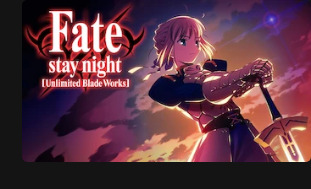
My usual pitch is that if you’re a normal person, you’ll probably go “This was a little confusing, but I really got into it: 8.3/10″, and if you’re like me and you never really gave up on wanting to become a superhero and save the world some day, you’ll go: “It was fantastic, 18/10, but it also ripped out my soul and left me wounded but somehow in an okay way.” Either way very worth watching. Since it’s not the first route, there are some things they don’t explain about the world because they kind of assume the viewer will know, but that’s pretty minimal--it’s def coherent enough that the more confusing bits are more of a “Uh, okay. I think.” than a “W-What the fuck is going on?”
It’s really good. Two seasons, the most beautiful fighting in almost anything I’ve ever seen, phenomenal soundtrack, and one of the best show opens (Season 2′s) of any show I ever saw. All around a just big blanket rec from me. It’s a long-time fan favorite for a reason. It’s one of my fave shows ever :’-] It was. Very personal to me.
Uhhhh what else--okay so, on Netflix if you watch it there, and a lot of streaming sites, they list “Episode 0″ or “Prologue” as the first episode? This was originally bonus content, not the first episode. It’s basically the first episode from not the MC’s point of view, but a different major character. It’s got some really great character moments and insight into Rin and Archer, and it’s fun, but since it was originally bonus, the pacing is super weird? So I would recommend you start with actual episode 1/Winter Days, A Fateful Night instead? Unless you just want to. Like it won’t mess up the show, but it might give you a weird idea of what the pacing is. So you can watch it first if you want, or later whenever you’re curious about those two, just like, if you start on it, don’t get overwhelmed by the stuff they’re not explaining, or the weird pacing. It’s supposed to be bonus content haha.
Very happy you’re interested! I really love UBW so I hope you enjoy it! If there’s anything else you want to ask feel totally free! I just don’t want to ramble for eight years about my special interest and fall into a black hole unprompted haha. : D Very happy you’ve been intrigued by my weird spike of fate content WAIT YOU ASKED ABOUT CRIME GRANDPA HOW COULD I FORGET.
Woof this is gonna be a long ask answer. Uhhhh, so Moriarty is from Fate Grand Order/Fate Go, the phone game. The game has three major arc sets so far: Grand Order, Epic of Remnant, and Cosmos in the Lostbelts. He’s from Epic of Remnant, and he’s universally beloved because he’s amazing. The MC in Fate Go is like 16, but he or she (you get to pick) is constantly having to risk their life and be hurt and traumatized and watch people die to save the world because there’s no one else to do it, and usually people are...not super nice to them. Moriarty shows up in the first of the second set of arcs and is like ‘Haha that’s a wholeass human child tho. Guys. Guys, a-are you sure about this?’ and he’s really there to pull of a massive evil culmination-of-my-life’s-entire-work-and-value scheme, but this kid is nice to him, and has nobody who looks out for them, and Evil Has Standards, so (Arc End Spoilers for that one ahead) he ends up giving up basically at the last minute. He had a plan that was totally working and could have won, but can’t really pull the trigger, because winning would mean this kid who has been nice to him and is already a massive pile of trauma and pressure and mental illness would die, and he cares more about them than his life’s goal. In Go usually boss fights are progressively harder, but his is super easy because he throws it, and chooses to lose, and basically throws away his life’s work for this one kid because nobody else is taking care of them, and lets himself get killed. This is a pattern with him. Other high points include later being 5 seconds into a scheme when Frankenstein (the girl one, who in fgo is like 14) stops him to call him Papa and asks for help, so he adopts her on the spot and just is her dad forever after that. He’s very goofy and I love him; he’s evil, but I’d trust him with my life, because he’s more good than he is evil, even though he’s both. Basically he’s just a very interesting and well written villain, but he’s also like, the /best/ dad in the game at the same time, and his dialogue is amazing. Evil Has Standards team dad poster man. He’s like the only adult in Fate Go who actually is responsible, which is fuckin wild. I’ll try to find some good screenshots of his dialogue. Anyway he’s incredible and I’m so happy you got him; Crime Papa is life.
Here have some Moriarty junk: (Shinjuku arc you have 3 partners, and the other two are adults but harass the MC constantly, and this was the dynamic. Bless Moriarty)

And here’s some him roasting Sherlock memes and being good dad to the MC

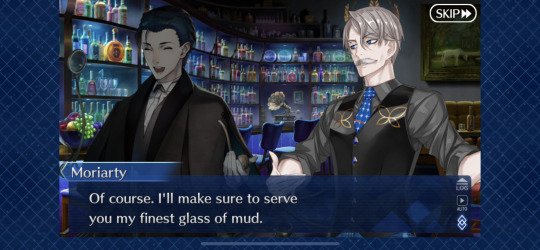
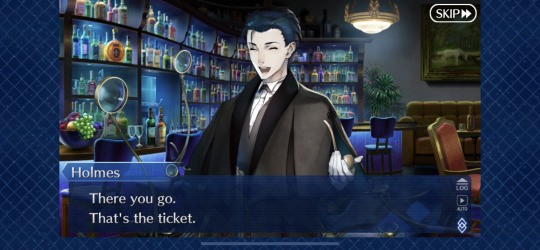
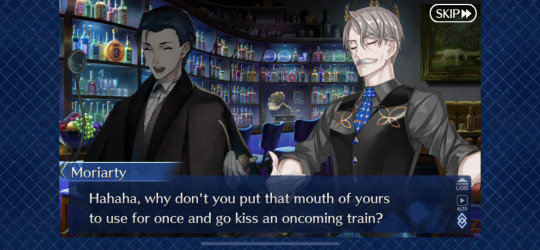

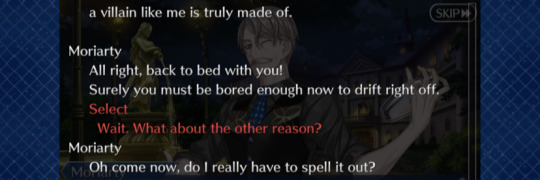
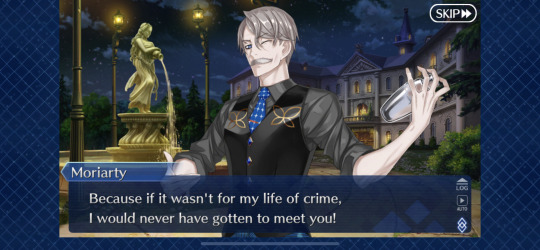
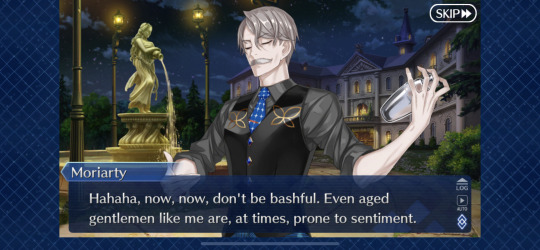
9 notes
·
View notes
Note
Aio-chan! I love how your blog has grown! But I have a question a bit off topic... If my memory is fine, I remember your first header was a Fate icon, wasn't it? Are you still a Fate fan? Are you making Fate content or just TWST content? And what is your favourite Fate arc? Which character you love the most? I'm sorry if this are too much questions ("◠��◠)
Well... I was not expecting this
I mean yeah, it's a bit too much off topic but I guess answering only this one would not harm anyone.
Was my first icon a Fate icon? Yeah, it was!
Am I still a Fate fan? Indeed, I love the series, the story, the characters... I couldn't ever deny it.
Am I making some Fate content of only TWST? Actually, only TWST. I would try doing Fate content but I wouldn't, it would be a little hard for me. Plus, I enjoy more reading that stuff than making it.
And what is my favourite Fate arc?
Definitely Zero and Lord El-Melloi II Case Files — Grace Note Rail Zeppelin. The soundtrack made by Yuki Kajiura and the animation is amazing too, Noble Phantasm's release is merveilleux ! Most of my favourite characters were born from this two adaptations, until Zettai Majuu Sensen Babylonia arrived. I'm a great fan of Grand Order too but from the animations, I loved this even more than Shinsei Entaku Ryoiki Camelot —the main reason is the soundtrack too.
Finally: favourite character...
And I am actually painfully waiting for Kani Jinkan Shinden Solomon. I have to confess that the first time I played Grand Order and finished The Grand Temple of Time: Solomon, I just cried a river. I fell for Romani's character that much that I didn't even realise it. And I'm sure that it will be a very well done work, I expect nothing less... And I'm sure it will become one of my favourite Fate animations, but for sure a part of my heart will hate it too. It's just so sentimental, enough to melt my stone-cold heart.
I guess the main is Waver Velvet. Waver is such a simple and complicated character all along the series, even with his relatively short participation on Grand Order. We follow the route of an immature young boy who just wants to prove the world that he's worthy of recognition, worthy of being a great mage but his ming suddenly changes when he starts comprehending Iskandar's vision. He is needy of love, not only of recognition and in some way that is what Alexander brings him. He starts growing when his servant dies, when his journey for honouring his memory starts. Becoming Lord El-Melloi II is more of a challenge than a punishment, in the end, he redeemed himself, he start accepting life as it comes and he, somewhat, starts recognising his proper value.
The second is another somehow complex but simple character and it's nobody else than Romani Archaman. The humble doctor. Not the greatest caster in the world nor the owner of the ten legendary rings. He's still cursed with the gift of vision, of seen the imminent end of humanity. He tries, and tries, and tries to save humans, he travels, he sees the world but that only leads him to the inevitable encounter with Marisbury. His fate was to save humanity, in the end, he experienced everything that means to be human, even the hardest pain. I just live his personality, how human they made him, the most powerful creature in the world.
Off the first place on my top, I have Merlin & Fou, Gillgamesh & Enkidu, Artoria Pendragon, Mordred & Gawain, Quetzalcoatl, Rin Tohsaka & Luviagelita Edelfelt, Astolfo and Henry Jekyll.
As well, Fate Prototype characters, mainly Merlin and Arthur.
God, I extended myself a lot with this one. Sorry, I never have off topics so I took the chance since it's related to the early origin of the blog~
7 notes
·
View notes
Photo




Fate/Grand Order Original Soundtrack I - IV
27 notes
·
View notes
Text
MUNDAY! ANSWER THESE QUESTIONS
tagged by: all of you buffoons
nicknames: i chose ren for myself to go along with my decision to use they/them pronouns; i do not perceive any of my past internet nicknames. have also been called renny, rennifer, renold, rennington, etc etc by several of you, as well as “goose” in viet by my parents.
zodiac: leo sun, pisces moon, leo rising. fire ox + rabbit ascendant (eastern)
height: 5′4″ though i haven’t actually measured myself in years LMAO so who knows
timezone: EST
listening to: fate/grand order original soundtrack iv, disc 2
last movie i saw: i could not tell you because i watch movies maybe once a year or so, but probably promare…
last thing i googled: …code geass because i had to double check something. i don’t trust my memory a lot of the time HAHA
average amount of sleep: somewhere between 6-8 hours. i can function on less, but i won’t be happy about it.
what i’m wearing: viet pjs but like the summer kind
dream job: something that pays enough for me to live comfortably but also isn’t physically demanding because my ankles hate me. minimal conversation also preferred do not interact with me
dream trip: idk honestly, my family used to travel for vacation every summer so there’s nowhere i really want to go anymore.
favorite food: kettle-cooked salt and vinegar chips
play any instruments: used to play violin. also used to sing and still technically do but exclusively to myself
eye color: brown.
hair color: dark brown, reddish tint under sunlight
languages: english, vietnamese (speaking only, and even then i’m not fluent), some fragmented japanese from studying it in high school
most iconic song: paramore’s brick by boring brick stuck out to me for all of middle and high school tbh
random fact about me: i let my sister try to cut my hair about a month ago because it was Goddamn hot and long dark hair bad. she was too impatient to do more than just haphazardly hack off chunks of it with scissors so my mom had to sit me back down and fix it to the best of her ability and i have very short hair now but my bangs constantly fall into my eyes without a hairclip.
reason for my url: regalblades is a nod to the weapon morph!lloyd wields in the final chapter of fe7, though ‘regalblade’ was taken so i tacked on an S at the end. alfvangr is a combination of ‘alfonse’ and ‘fólkvangr’ to match fenrena (sharena’s url), though i previously had his url as ‘sessrumnirse’ which was a nod to the goddess freyja’s hall located within fólkvangr in norse mythology.
tagging: if you haven’t done this yet. come closer.
13 notes
·
View notes
Photo

Blue Hawaii (1961)
Elvis Presley’s ascent to stardom struck the United States (and the world) like a lightning bolt. Hounded from Nashville’s Grand Ole Opry due to the country music establishment taking offense to his genre-blending musicianship, Elvis grew from being a regional phenomenon to a national sensation as he helped innovate rockabilly, a form of rock and roll. Movie producers, sensing an opportunity to cash in on Elvis’ skyrocketing popularity, gave Elvis star vehicles such as Love Me Tender (1956) and Jailhouse Rock (1957). Critics shrugged at these films – low-budget affairs where most of the budget went to Elvis’ salary – but his fans made them critic-proof, turning out in droves to scream and swoon at their slick-looking dreamboat. Grappling with television’s advent and the dissolution of the Old Hollywood Studio System, Hollywood’s major studios shifted their efforts towards more bombastic, showman-like films. Such was the situation in the early 1960s that longtime Warner Bros. producer Hal B. Wallis (1938’s The Adventures of Robin Hood, 1942’s Casablanca), now at Paramount, joked that, “a Presley picture is the only sure thing in Hollywood.”
To the horror of Elvis’ fans and movie studio executives but to the delight of those fans’ parental figures and teachers, the U.S. Army drafted him in March 1958. Elvis served twenty-four months before his discharge with the rank of Sergeant. During his service, Elvis nevertheless had plenty of singles in the can, many ranking high on the charts while he was at basic training and later his posting in West Germany. Looking forward to restarting his musical and acting careers, Elvis soon returned to the recording studio and shot G. I. Blues (1960) – he had discussed the film with Wallis months prior to his discharge – in short order. For the eighth film of his career and his fourth after his discharge, Elvis starred in Blue Hawaii, directed by Norman Taurog (1938’s Boys Town, nine Elvis films) and produced by Wallis. The film stars Elvis as an Army veteran recently discharged from the service, returning to his home state. I wonder where did they get that idea from? It also marks the unlikely beginning of Elvis’ association with the Aloha State – which shed its territorial status in 1959 and was ready for a Hollywood treatment that had nothing to do with the Japanese attack on Pearl Harbor.
Chadwick “Chad” Gates (Presley) returns home to Hawai’i from his military service, greeted by girlfriend Maile Duval (Joan Blackman: “MY-lee”) and a flower seller named Waihila (Hilo Hattie in a cameo). Instead of immediately seeing his parents – mother Sarah Lee (Angela Lansbury, only ten years Elvis’ senior) and father Fred (Roland Winters) – he escapes to a secluded oceanside shack with Maile and his Hawaiian surf buddies. Chad is the son of pineapple plantation owners, and Sarah Lee wants him to succeed Fred when the time comes. But Chad is not interested in those plans, electing instead to work as a tour guide for Mr. Chapman’s (Howard McNear) travel agency – among other things, Maile works at the agency. The first tour he gives serves schoolteacher Abigail Prentice (Nancy Walters) and her four teenage students, all girls. One of those girls, Ellie Corbett (Jenny Maxwell), appears standoffish at first but then begins to flirt shamelessly with Chad.
If by that point in Blue Hawaii you are still concentrating on the plot, just note that your approach to watching Elvis movies is not advisable. Watching Elvis movies for a sensible plot is to invite frustration; accept the narrative drivel and enjoy.
Shot mostly on location on the Hawaiian Islands of O’ahu and Kaua’i, Hawai’i offers splendid backdrops to even the most mundane scenes of this film. Charles Lang’s (1947’s The Ghost and Mrs. Muir, 1959’s Some Like It Hot) camera allows characters to be dwarfed by the green mountains in the distance, the crystal blue waters extending to the horizon, and palm tree fronds wafting amid a gentle breeze. Scenes of breathtaking natural beauty abound in Blue Hawaii. In conjunction with the production (Hal Pereira and Walter H. Tyler) and set design (Sam Comer and Frank R. McKelvy), Blue Hawaii becomes, by default, the most colorful Elvis movie to date. The film, by design, partly becomes a tourism advertisement for the new state. Its white characters and filmmakers exotify and romanticize Native Hawaiian culture to fit their own expectations and perspectives – these sorts of depictions have endured across the last century, figuring heavily in cinema (1935’s Honolulu: The Paradise of the Pacific as part of [James A.] Fitzpatrick’s Traveltalks for MGM) and tourism advertising. This is the first live-action feature film from a major Hollywood studio to make even a minimal attempt to depict native Hawaiian culture since Waikiki Wedding (1937), another Paramount film.
Here are some more connections between Waikiki Wedding and Blue Hawaii: both share one song (“Blue Hawaii”) in both their soundtracks and both films are musicals. The Hawaiian musical sound is just as integral to popular conceptions of Hawai’i, and it is used liberally here in orchestrations, if not melodic structure. Blue Hawaii’s soundtrack contains the greatest amount of songs (fourteen) for an Elvis film. For those who enjoy their breathless musicals with a song at every turn, Blue Hawaii does just that. The musical numbers arrive in the most innocuous situations – from forming a melody from a tune heard on the radio, an impromptu jam session with a guitar conveniently within arm’s length of Elvis, or starting from nothing. The worst of the soundtrack avoids many of the novelty songs that plague Elvis films, especially the later entries. Given how nonsensical the plots to Elvis movies are, the lower-tier songs in Blue Hawaii are preferable compared to more stilted acting and fraternizing shenanigans. Thus, the bar is raised, and the inclusion of two non-original songs – “Blue Hawaii” (music by Ralph Rainger, lyrics by Leo Robin) and “Aloha ‘Oe” (Queen Lili’uokalani) – are arranged in such a way that beautifully complements Elvis’ velvety singing voice. Among the original songs, “Moonlight Swim” (music by Ben Weisman, lyrics by Sylvia Dee) is a sensuous, laid back song that perfectly serves Chad’s characterization: an unabashed Casanova, effortless in romance, a hint of masculine arrogance.
The runaway hit of the Blue Hawaii soundtrack is among Elvis’ most popular songs. “Can’t Help Falling in Love” – music and lyrics by Hugo Peretti, Luigi Creatore, and George David Weiss – appears approximately midway through the film as Chad says hello to Maile’s grandmother (Flora Kaai Hayes, a former Hawaiian Territorial Representative to the U.S. House of Representatives) for the first time since before his military service. It, like so many other musical entries in Blue Hawaii, arrives without much warning, backed by a constantly harmonizing music box and a steel guitar played in a Hawaiian style. One might take issue with the song’s use in context, but it is a crooners’ standard that has crossed linguistic barriers worldwide. Its simplicity is self-evident: a memorable melody, chorus, and a minor key bridge aching for resolution as it modulates to major key. Perhaps “Can’t Help Falling in Love” is not considered one of the greatest original songs in movie history because of the questionable quality of the film it appears in. More likely, Elvis’ gravitational pull as a crossover music and movie star writes its own legends that defy a critic’s or a historian’s corrections.
youtube
Somehow, I have written all the above without remarking on the acting. Other than Elvis himself, everyone else is a passing interest at best. Joan Blackman’s chemistry with Elvis is apparent, but she does not distinguish herself from every other female lead in an Elvis movie. Angela Lansbury’s exaggerated Southern accent displays her considerable range, even if there are better examples in other films. As much as some may deride Elvis’ performances for being unchallenging, one could not imagine an Elvis movie without the star attraction. His persona is effervescent; his charisma incontestable. According to Weiss, Elvis’ comedic instincts manifested themselves in subtle ways. If Elvis requested a joke to be explained in discussions about the screenplay, it was his roundabout, maybe overly polite, way to warn Weiss, Taurog, and screenwriter Hal Kanter (1952’s Road to Bali, at least twenty-two Academy Award ceremonies) that the joke was not funny. During test screenings of Blue Hawaii, every joke kept in the film that Elvis questioned elicited nothing from the audience. On- and off-screen, an Elvis movie with Elvis removed would collapse from the void of hilarity and charm such an absence would create.
Blue Hawaii, like all other Elvis movies prior, succeeded at the box office in comparison to its budget. Adding to this bounty for Elvis, the film’s soundtrack album sold millions of copies, sitting atop of the Billboard charts for twenty weeks, and garnering a Grammy nomination. The soundtrack profits from Blue Hawaii and the preceding G.I. Blues led Presley’s obstinate manager, Colonel Tom Parker, to have his client concentrate on film soundtrack albums at the expense of non-soundtrack albums – setting the groundwork for the remainder of the 1960s (Elvis released 16 soundtrack albums versus six non-soundtrack albums during this decade), with diminishing returns. Parker reasoned to Elvis that his fans demanded to see him in these musical romantic comedies, rejecting any roles that did not fit this mold. Elvis, believing his manager, continued to make films until well past the point an Elvis Presley picture was a guaranteed hit in theaters.
In its visual splendor and Pacific appeal, Blue Hawaii sealed the fate of Elvis’ post-Army career. No other subsequent Elvis film would match the commercial heights of Blue Hawaii, although one could argue several of those movies surpass this one in terms of acting, aesthetics, and musical interest (like 1964’s Viva Las Vegas and two concert documentaries in 1970 and 1972). Elvis returned to Hawai’i several more times during his career for concerts and two films – Girls! Girls! Girls! (1962) and Paradise, Hawaiian Style (1966). As much as Elvis is associated with Tupelo, Mississippi (his birthplace) and Graceland in Memphis, there is also a special relationship between Elvis and Hawai’i. That relationship – one that touches Elvis’ personal life and the musical traditions of Native Hawaiians – begins with Blue Hawaii, an archetypal Elvis film and one of his best.
My rating: 6/10
^ Based on my personal imdb rating. Half-points are always rounded down. My interpretation of that ratings system can be found in the “Ratings system” page on my blog (as of July 1, 2020, tumblr is not permitting certain posts with links to appear on tag pages, so I cannot provide the URL).
For more of my reviews tagged “My Movie Odyssey”, check out the tag of the same name on my blog.
#Blue Hawaii#Norman Taurog#Elvis#Elvis Presley#Joan Blackman#Angela Lansbury#Nancy Walters#Roland Winters#John Archer#Howard McNear#Jenny Maxwell#Lani Kai#Hal Wallis#George David Weiss#Hugo Peretti#Luigi Creatore#TCM#My Movie Odyssey
8 notes
·
View notes
Note
hey!! bro ur my number #1 source for lupin III content so can I ask like how in the hell I go about watching all the series / movies / etc for it in order??? I’m really pumped for the live action so I wanna at least dip into all the other stuff. thanking ya kindly //tips hat
hello!!! what an honor!! oh my… ok I’m so sorry in advance… I’ve gotten a few similar asks and I started writing out a list and it was getting over 1500 words long so I had to try to chill out…so…
LUPIN III CRASH COURSE
I’m sorry that this is so long.. and consider I cut it down! but here is my intro because I know this franchise is huge and confusing!! (I’ve had multiple instances of friends being like ‘I tried to find that Lupin thing you like but I could only find the third one?’)
I kind of liken it to Scooby Doo? it stretches some 60 years and has been handled by many different writers, directors, and animators across very different eras? most important to know! the order doesn’t really matter and things aren’t really sequential (save for where the three most recent shows) so you can jump in and explore whatever seems compelling! it’s overwhelming because there is so much but also nice because there’s something for everybody! if you like fun and pure, edgy, etc. etc.
feel free to disregard everything coming… I will say my personal priority order is
- Castle of Cagliostro
- some episode of part 2
- part IV, ideally all of it! there’s filler but it’s hard to know which ones
- part I (or some episodes of it? up to you!)
- Fuma Conspiracy
- part V
- part III (it’s great too!! just not as sequential as IV and V)
- First Contact… truly indulgent but its so cute!
(below I broke down a little about each and my favorite episodes, where to find them, etc. and there’s so much more but just doing everything below is a whole lot)
TV (All the shows except for The Woman Called Fujiko Mine are on Crunchyroll!)
Part 1 (1971) - crunchyroll!
The beginnings kind of a weird feeling because the first half was directed with one vision vs. the second half being co-directed by Takahata and Miyazaki, there’s a shift in Lupin’s personality and most significantly they sought to shed his ‘sense of apathy’ and make him more of a hero? something that’s echoed later on! honestly, I don’t think the transition is as dramatic as some people find it? but it does shift across the episodes and end on a sweet note!
truly they all have something to enjoy but I made note of
episodes 2, 4, 5, 7, 9, 11, 13, 16, 18, 19, 23
for some reason? really really suggest watching the last episode! but get a bit of the first and second half beforehand!
Part II/Red Jacket (1977-80) - 155 episodes - on crunchyroll dubbed and subbed
there are a lot so I tried to narrow it down to a few of my favorites/ particularly noteworthy ones? I bolded my absolute favorites! I’m sure I missed a few but save for a few two-episode arcs you can jump in anywhere and it’ll be fine.
episodes 1-79 are dubbed on Crunchyroll! In my personal opinion the script makes it worth it!! there are a bunch of non-dubbed episodes anyway if you want to get a feel for both
(these episode titles are often hilarious, misleading, and/or horribly embarrassing?)
1 - ‘The Return of Lupin the Third’ - just a good starting point!
5 - ‘Will the Leaning Tower of Pisa Be Standing?’
6 - ‘Tutankhamen’s 3,000-Year-Old Curse’
7 - ‘Venetian Super Express’ - I want to say this is a cute little road trip episode? it’s been so long
9 - ‘Steal the FIle M123’ - this dub… madness. very strange Christopher Walken impression for absolutely no reason?
10 - ‘Bet on the Monaco Grand Prix’
15 - ‘Crude Reproduction, Perfect Frame’ - Lupin keeps committing strange and uncharacteristic crimes, but he has no memory of doing so!
29 - ‘Fly Me to the Moon’ - Lupin has some mysterious Levitation Technique and everyone is after it
32 - ‘Lupin the Interred’ A famed hitman is after Lupin!
34 - ‘But Your Brother Was Such A Nice Guy’ - this episode is one of the zaniest ones and that’s saying a lot… Vampires? Jesus? Really really funny moments though especially in the dub
42 - ‘Cruisin’ in Drag’ Lupin infiltrates the ship of a wealthy bachelor disguised as a woman
45 - ‘Diamonds and Minx’ kind of a mess of people stealing from each other?
46 - ‘The Island of Dr. Derange’
57 - ‘Alter-Ego Maniac’ - Inspector Zenigata goes criminal
62 - ‘Church of the Poison Mind’ - Jigen and Goemon stumble into a religious cult
69 - ‘Zenigata Getcha Into My Life’ - this title is awful but this episode is great.
78 - ‘Ice, Robot’ - an inventor has made a machine that can cry diamonds!
79 - ‘Baton Death March’
81 - ‘Fujiko, Men are a Sorry Lot!” - Fujiko gets engaged to a Prince, the rest of the gang goes after the monarchy’s Golden Bell
96 - ‘Lupin’s Gourmet World’ tbh this is a vore episode but there are some great gang moments here and a really fun third act
99 - ‘Fighting Jigen’ - first anime episode (I think like in history? but I could’ve misread) in stereo! And I believe the first to air of the TMS staff’s work, you can tell because the style shifts to a more Miyazaki/Cagliostro look and this will keep happening for the rest of the show
101 - ‘Fervent Love at Versailles’ - a crossover episode with Rose of Versailles!
103 - ‘The Wolf Looked at an Angel’ - Goemon is an angel I can say little else
104 - ‘The Most Dangerous Golden Bed’ - debut of perhaps the best opening! I love this episode?? so much?
112 - ‘Danger! Goemon’
122 - ‘An Unusual End to an Expedition for Napoleon’s Treasure’
143 - ‘The Miami Bank’
145 - ‘Wings of Death: Albatross’ - ah yes, one of the famed Miyazaki-directed episode, truly so worth it
151 - ‘To Arrest Lupin, the Mission at the Highway’ - another not exactly Miyazaki episode but a lot of the people he trained? They depart from the part 2 style(s) again but its a good bit of fun all around! Really lovely character animation
152 - ‘Jigen and the Hatless Pistol’ - Jigen loses his hat and thus his ability to shoot
155 - ‘Thieves Love the Peace/Farewell, Dear Lupin’ - the finale episode! Miyazaki-directed as well, and just beautiful
Part III (1984) - 50 episodes - crunchyroll!
I’m still very early in this one so I can’t say much yet! But it gets a bad rep? Perhaps for being more inconsistent stylistically and a bit on the zanier end! But I really like it!! these drawings are such a blast! I think each bit has its merits and this one is no exception. Plus with all their freedom animation-wise they can do a lot of fun stuff!
The Woman Called Fujiko Mine (2012) - 13 episodes - on kissanime for certain and I think animetake?
this is the most dramatic departure from the rest of the shows/films/specials. Fujiko Mine is the star of this part! It definitely has less obviously plot-important episodes but it’s one narrative from start to finish. I must note that it’s by far Lupin’s edgiest, I think it’d be safe to deem this part as R-Rated. There’s sex, violence, sexual violence, abuse, bodily mutilation, obsession… a gay character who gets a pretty tragic fate (at first I was excited by the very existence of an LGBT+ character but he really goes through the wringer and never gets a resolution.. I don’t want to spoil). This is probably Lupin at his ickiest? I do like Jigen’s personality here! And his dynamic with Fujiko, but it’s a lot more disjointed than the other parts. She meets each of them separately and towards the end, Lupin and Jigen interact more but there’s barely a time when they’re all together. That’s not meant to be a deterrent but personally, I’m a sucker for their friendship and love them as a group so it’s a bit of a bummer. Sequential plot-wise though! This one is definitely captivating, a bit disturbing, and there is a plot-twist that really got me. The villain design is really cool too!
Part IV (2015) - 26 episodes - on crunchyroll, also dubbed on Funimation
This part is narrative-based and sequential! It still has some more standalone episodes but there’s definitely an overarching story throughout! I think they’re all worth watching and might leave little important bits that’ll be confusing later on. Essentially this part takes place in Italy for the most part and starts with Lupin getting married to a multi-millionaire heiress/model/celebrity who wants to get into the thief business. This one feels like a good combination of old and new, it’s not quite as silly as the earlier parts can be, but it’s full of nostalgia while still feeling original. I really had a good time!
This dub isn’t bad but!! It comes with a different opening and soundtrack, I guess Lupin’s pretty big in Italy and perhaps there were licensing issues? I’m not sure? But it’s a bit of a bummer to be without the Yuji Ohno soundtrack. The alternate opening feels more like a collection of stills and footage found throughout the show? It’s not horrible, just different! Regardless, the Part IV Japanese OP (vs. the Italian/US one) is worth a watch!
Part V (2018, airing on Adult Swim right now, summer 2019!) - 23 episodes
I’m actually not done with this part but its good fun! more directly tied to part iv then the others are to each other. It’s more sequential as well with a few sub-arcs and since it fell on the franchise’s anniversary it has callback episodes with Lupin in various jackets in various tones. Interesting Lupin characterization here… he seems… sadder, wistful? and we get hints of Lupin lore! Lots of fanservice but… I love it! I still think they could’ve pushed it more? it feels somehow more reserved than part IV in some ways, which is already different from the 70s and 80s, but it’s got a lot of lovely moments!!
Films/TV Specials
From 1989 to 2011 they had a special every year!! So much!
Castle of Cagliostro (1979) - Available on Netflix!
perhaps the best-known piece of media in the Lupin franchise? And rightly so. This film is Hayao Miyazaki’s directing debut and a blast from start to finish! This characterization of Lupin is definitely Miyazaki’s more than Monkey Punch’s but that seems to be the strange nature of the Lupin franchise! I could really go on forever… please watch it!
The Fuma Conspiracy (1987) -
perhaps harder to find, but it’s on Kissanime! Goemon is getting married but before the ceremony is over the bride is taken by the Fuma ninja clan and the gang helps him to get her back as well as learn the story of a family heirloom? Really great stuff from everybody! Adorable Zenigata, the fluffiest and most handsome Goemon, cute Jigen, Fujiko, and Lupin interactions, a really really incredible car chase! Even with Cagliostro’s fame, this one has got some serious pizzazz
Episode 0: The First Contact (2002) - on Kissanime as well!
A journalist asks Jigen how he met Lupin III, this is probably my favorite TV special? And features one of my favorite opening scenes in the whole franchise. The instrumental!! Perhaps each member of the gang at their purest, whatever that means, really great moments between everybody and peak Lupin and Jigen meeting and somehow signing up to be life partners
#oh my god#i'm so sorry#please.. feel free to ignore this#lupin#lupin the third#lupin iii#lupin the 3rd#diggitydamnsebastianstan
92 notes
·
View notes
Photo
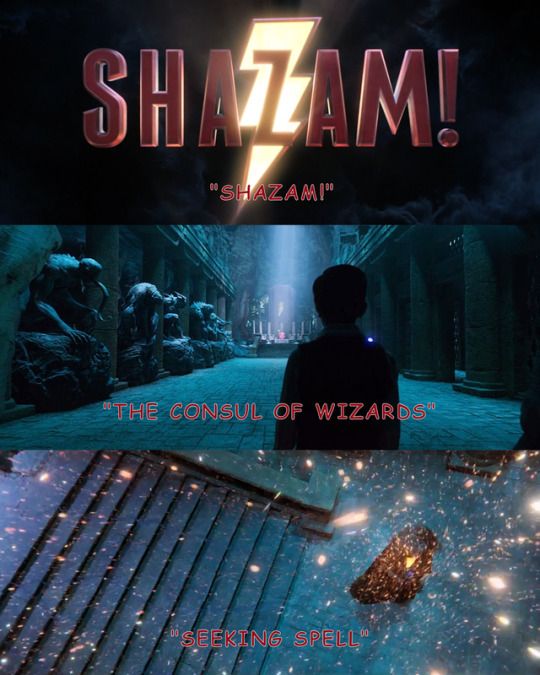
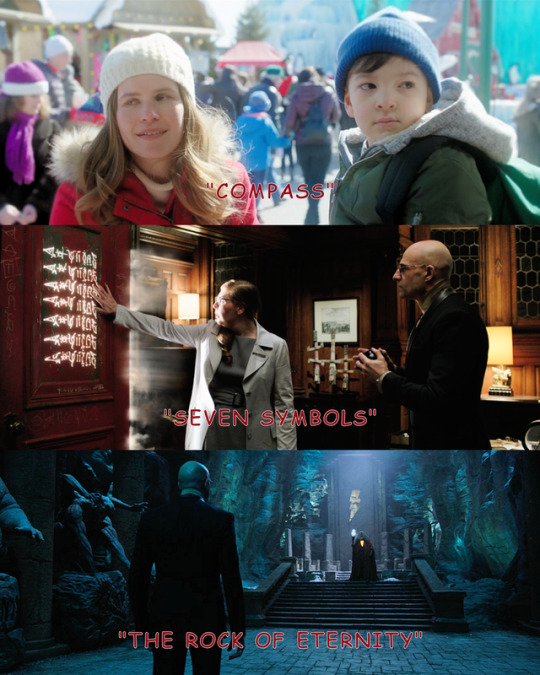
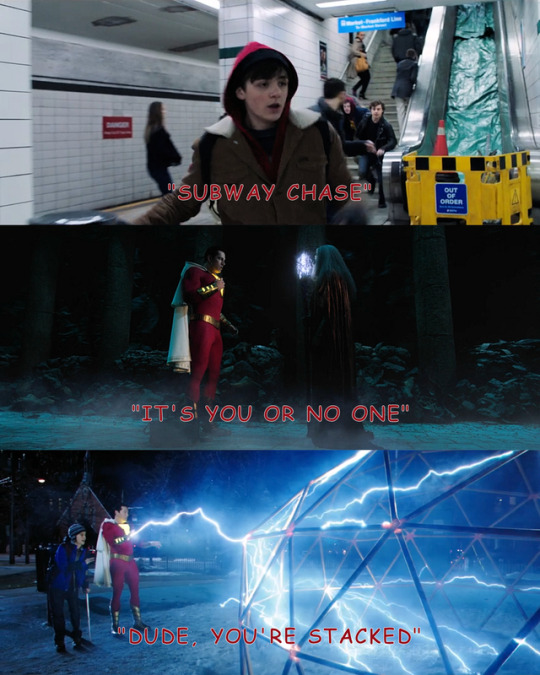
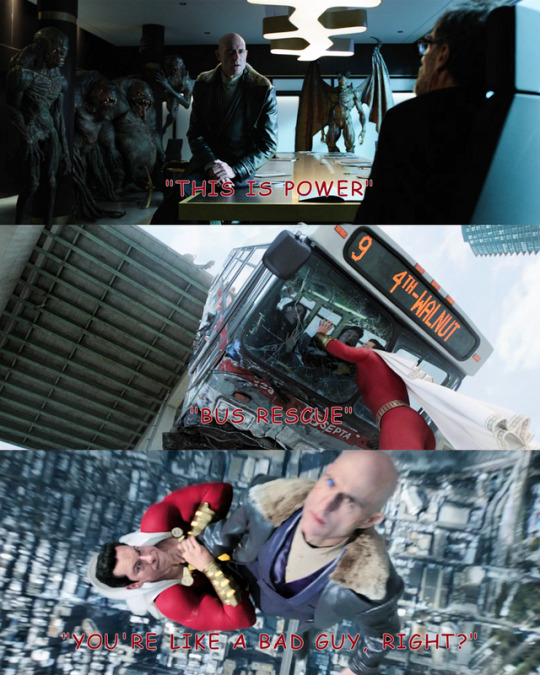
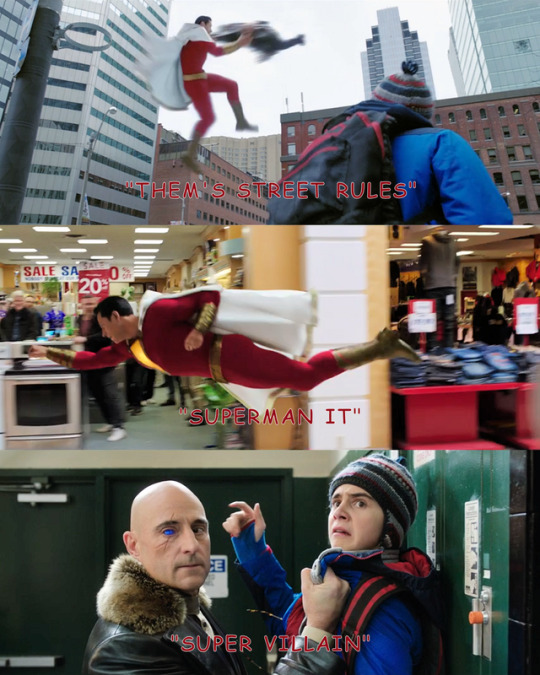
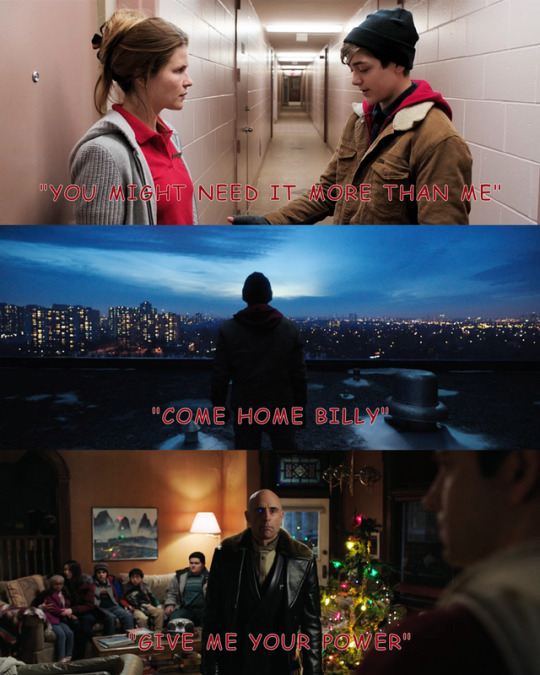
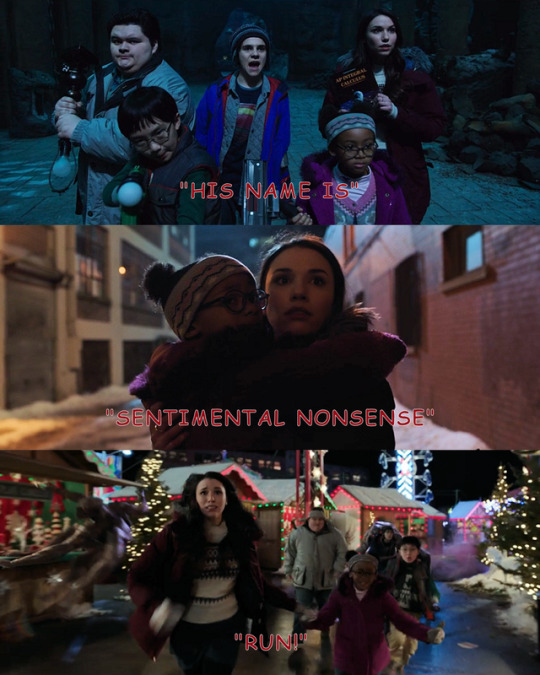

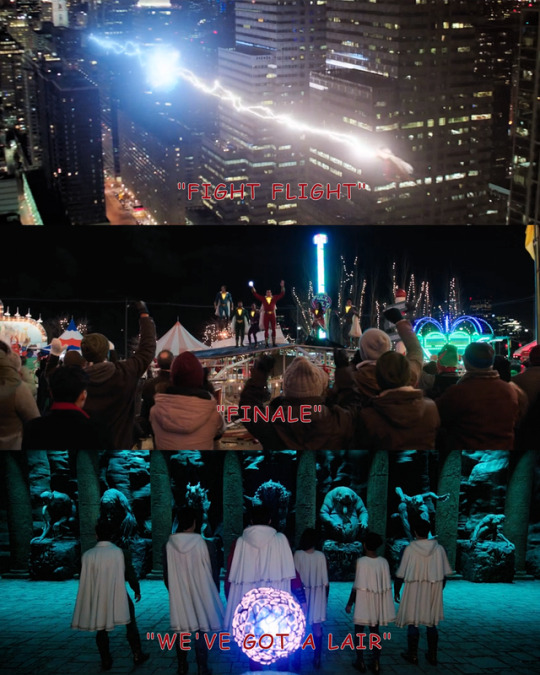
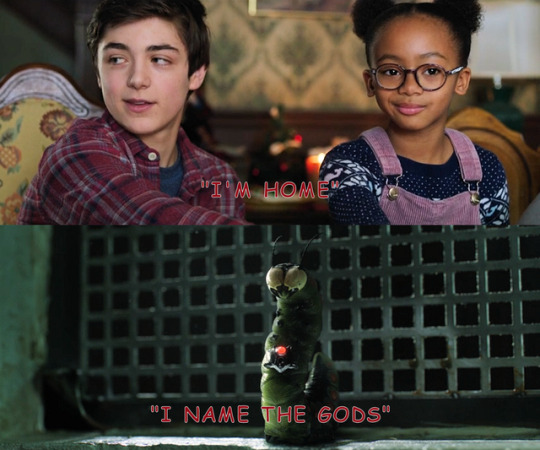
Music, Maestro!
You, Darla fans, remember that one publication I made about the non-orchestral songs for the film Shazam!, right? Well, here are now the full orchestral songs of that same film, conducted by Londoner Benjamin Wallfisch. But first, here is his bio:
Born August 7, 1979 as Benjamin Mark Lasker Wallfisch, the son of Elizabeth Wallfisch (née Hunt), an Australian Baroque violinist, and Raphael Wallfisch, a British cellist. He is the eldest of their three children. His paternal grandparents are pianist Peter Wallfisch and cellist Anita Lasker-Wallfisch, who was a member of the Women's Orchestra of Auschwitz. They were Jewish emigrants from Breslau, Poland.
He has composed and contributed to music for over 60 feature films since the mid-2000s. Asides Shazam!, his compositions include original scores for A Cure For Wellness, Hidden Figures, Lights Out, Desert Dancer, It (2017 version) and Blade Runner 2049. In 2017, he was jointly nominated with Pharrell Williams and Hans Zimmer for Best Original Score at the 74th Golden Globe Awards for his work on Hidden Figures, and a BAFTA Award and Grammy Award for Blade Runner 2049.
In 2014, Wallfisch was appointed an Associate of the Royal Academy of Music, London. He is also a member of Remote Control Productions, a company by Hans Zimmer.
Wallfisch resides in Los Angeles, California with his wife Missy and daughter Lola.
Here is the YouTube link to the soundtrack available to hear: https://www.youtube.com/playlist…
Music 1 - The Shazam! theme is played during the end credits, right after the mid-credits scene.
Music 2 - In a flashback scene from 1974, young Thaddeus Sivana (Ethan Pugiotto), while riding with his father and older brother in Upstate New York on Christmas Eve to his grand-parents' mansion, got suddenly transported, alone, to a place called the Rock of Eternity where he would meet this mysterious wizard as this latter was looking for a pure-hearted champion to replace him. However, after being tempted by the Seven Deadly Sins, trapped in statues, to take the Eye of Sin for power, the wizard reconsidered and sends him back to 1974. This piece was heard during that scene.
Music 3 - This score was played while the Shazam! Wizard, growing weaker, uses his seeking spell to continue looking for a champion, no matter how long it takes. It would finally pay-off in the year 2019 in Philadelphia - to a street boy named Billy Batson.
Music 4 - Billy Batson, age 14, kept on searching for his long lost mother since a decade ago from place to place, until he found one hoping this would be it, This piece was heard while he reminisced about how he lost his mother at a carnival. We see little Billy, age 4 (David Kohlsmith), with his mother (Caroline Palmer) as she was trying to pop the balloons with darts to win a prize for her son.
Music 5 - The once young Thaddeus Sivana has eventually grown up and becomes Dr. Sivana, who had never forgotten his encountering in 1974 and vowed to return to the Rock of Eternity and gain power from the Eye of Sin. While we hear this score, Sivana figured out, through interviewed witnesses from around the world, that there were seven symbols needed being written seven times. A skeptical Dr. Lynn Crosby (Lotta Losten) didn't believe it until the door in Sivana's office activated the passage to the cave - and in the process reducing Dr. Crosby to dust, but her glasses.
Music 6 - Returning at last to the Rock of Eternity after all these years, Dr. Sivana confronts the Shazam! Wizard (Djimon Hounsou) to take the Eye and gain power, which he finally did and got the best over the wizard while this score is playing along.
Music 7 - Billy Batson (Asher Angel) is being chased by the Breyer twins (Carson MacCormac & Evan Marsh), in the background, from Fawcett Central School to the nearest subway station after rescuing his foster brother Freddy from their bullying. This incident was perhaps fate as the following event will occur, changing his life forever. This music was played throughout.
Music 8 - While this music is played, Billy meets the wizard choosing him as the new champion. By saying the magic word and touching his staff, the wizard can at last transfer his powers to the new champion, Shazam!, giving him: - The Wisdom of Solomon - The Strength of Hercules - The Stamina of Atlas - The Power of Zeus - The Courage of Achilles - And the Speed of Mercury The wizard then vanishes into dust, leaving Billy with his new adult body and super-strength.
Music 9 - Knowing that his new brother, superhero fanboy Freddy (Jack Dylan Grazer), might help him with his new identity, Shazam! (Zachary Levi) lets him in on his secret. Together, they found that he was indeed "stacked" with super-powers.
Music 10 - Revenge can be sweet, whether for good or bad, as we see Dr. Sivana, after killing his brother Sid along with the other members of a board meeting at Sivana Industries, confronting his father (John Glover) to make him see that he gained power, with the help of his allies, the Seven Deadly Sins - and killing him as well afterwards.
Music 11 - While showing off his new lightning powers to the people outside the Philadelphia Museum of Art, Shazam! accidentally struck a bus's front tire, driving it to the edge. After his awkward attempt to use an old mattress in hoping it would soften the fall, our new hero had to catch the enormous vehicle - with a satisfying result, saving everyone inside it.
Music 12 - Dr. Sivana finally meets this new champion and demands him to hand his powers over to him immediately. This battle with a super-villain was Billy's ultimate test. Sivana however got the best of him, as our new hero couldn't fly yet, by grabbing him and bringing him up high in the atmosphere and lets him go to a dooming fall.
Music 13 - After his dooming fall, Billy halted to a close shave as he could finally fly and had to deal with this new foe in black in a new definition of street-brawling, all under the watchful eye of Freddy.
Music 14 - The brawl between Shazam! and Dr. Sivana went on as they ended up in the mall and in a toy store. After being slammed by Sivana through the store window, Shazam! had to get away from him by flying inside the mall before being struck by Sivana. Having no choice, Shazam! transformed back to Billy in order to blend in with the panicking crowd.
Music 15 - Seeing that Freddy was looking for Billy, and realizing the latter would supposedly be the new hero according to the bus rescue news report on the TVs at the mall, Sivana forced the crippled fanboy to tell him where he lives, which would put the other kids in danger as well.
Music 16 - At long last! Billy, thanks to Eugene's search online, has finally found his long-lost mother, Marilyn, who has moved on and remarried while his real father, C.C., was in prison in Florida for ten years. Billy found out that she has abandoned him on purpose because she couldn't afford to keep him since she was too young. Billy then tells her that he too had to move on to his new family.
Music 17 - After his reunion with his real mother, Billy received a call from Freddy's phone by Dr. Sivana, letting him know that he holds his foster siblings hostage and demands that he comes home immediately.
Music 18 - Forcing to return home to save the others, Billy was ordered by Dr. Sivana to relinquish his powers to him after their arrival to the Rock of Eternity and will let them go, or else they will die. In tears, Darla (Faithe Herman) pleaded Billy not to go and stay with them, but Billy tells our bespectacled beauty that that's what good big brothers would do.
Music 19 - Following Billy and Dr. Sivana to the Rock of Eternity, Darla, Eugene (Ian Chen), Freddy, Pedro (Jovan Armand) and Mary (Grace Fulton) found whatever they salvaged from home and decided to take head on against Sivana and his "big fat ugly-eyed head, " as Darla would put it bravely, until he lets Billy go.
Music 20 - Here, we see Mary being such a great big sister watching over Darla as they watched Dr. Sivana blasting out through the roof of The Booty Trap strip club. The kids have no time to waste and ran to the nearby carnival in hoping to lose themselves inside the crowd. Protect our little Darla, Mary. We love her so much.
Music 21 - In a divide and conquer method, Mary would hope that Sivana would not be able to follow all of them. However, the dangerous doctor sends his Seven Deadly Sins after them, and succeeded.
Music 22 - Billy managed to escape from the clutches of Dr. Sivana, but the latter has the others hostage, yet again, inside the big tent. When he threatened of having Darla killed by Greed (YOU MONSTER!!!), Billy had no choice but to give in.
Music 23 - While Billy had to relinquish his super-powers to Dr. Sivana, he remembered what the wizard told him about sharing his power with the others by simply touching the staff. Not giving up yet, he managed to defeat Sivana and taking the staff away from him, with enough time to share his powers with his new family, becoming superheroes themselves.
Music 24 - It is done - the kids, thanks to Billy, have now become superheroes with their own unique abilities, including Freddy who can now fly as Super Hero Freddy (Adam Brody, in blue) with full joy.
Music 25 - While our new family of superheroes fight against the Seven Deadly Sins, Shazam! and Dr. Sivana face-off for what may be a final showdown in the Philadelphia skyline.
Music 26 - Shazam and the rest of the Shazamily finally won against Sivana and saved the city from destruction. And at the same time, they gained fandom from the cheers and applause of Philadelphians, resembling very much of a big stage play.
Music 27 - Returning back to the Rock of Eternity and placing the Eye of Sin back to its rightful place, thus imprisoning the Seven Deadly Sins back in statues, they realize along the way that they have something else - a lair. They have their own lair - something Billy and Freddy were looking for during the film, even by asking a real estate agent about one.
Music 28 - The following Christmas morning, the whole family gathered for breakfast and Billy told them that he finally found a new family - them - and how much he is very grateful for that.
Music 29 - In a mid-credits scene, when we hear this musical score, an imprisoned Thaddeus Sivana, still looking for a magic formula by writing on the walls, is approached by this talking caterpillar, going by the name Mr. Mind, who proposes an alliance between the two and there are alternate ways in discovering magic.
#shazam#shazam movie#shazam film#shazam ost#music in film#music in movies#darla dudley#faithe herman#eugene choi#ian chen#freddy freemen#jack dylan grazer#pedro pena#pedro peña#jovan armand#mary bromfield#grace fulton#billy batson#asher angel#zachary levi#thaddeus sivana#mark strong#shazam wizard#djimon hounsou#mister mind
22 notes
·
View notes
Audio
#sealed ends of the four seas: okeanos#number 201#fate series#fate grand order#fate grand order: original soundtrack i.
20 notes
·
View notes
Audio
#type moon#fate series#fate grand order#fgo#music#fate/grand order#fate go#i haven't seen it posted here so#have this#have this and be reminded
292 notes
·
View notes
Audio
Only a couple of months until LB3 is on the CN server! I blew all my quartz trying to get a second copy of Skadi, so uh...
Support the original artist by purchasing the album: https://www.fate-go.jp/music/ost3.html
#one of my favorite tracks from fgo#best map theme#lb3#map theme#lostbelt 3#lostbelt#fgo#fate#grand order#fate grand order#sin
11 notes
·
View notes
Text
About Music
Like everyone else, I have my preferences when it comes to music. Unlike a lot of people, however, my taste doesn’t seem to follow mainstream bands or musicians very closely, to the point where I have never heard of many of them.
Based on that it might sound like I am very picky about the kind of music I like, or like there is some specific style that is the only one I can enjoy. I don’t think this is the case (though I do lean towards orchestral, piano, and violin music).
I notice that I can like a variety of songs, but what I enjoy is based on certain underlying principles that seem to be linked to basically all music I like.
I’m not a music expert or anything, but I’m going to use this post to explain what I like and why, and provide examples.
Association
The first thing that can heighten my appreciation for a song is association: What the song reminds me of. I noticed that a lot of the music that I end up really liking is music that appears in other media (such as games), likely because of this effect.
Listening to music, especially in a focused way, brings up mental images and feelings that are part of a specific “mood”, and when the music is both memorable and in tune with the media it appears in, it can make a huge difference for me.
For example, consider Touhou music. There isn’t really a Touhou song that I dislike, but I do notice that my appreciation for the themes grows after listening to them in-game, because the music contributes to the atmosphere of the game and the atmosphere of the game helps create mental images for the music.
This association effect is pretty much always at play for me. It can increase my enjoyment of practically all genres as long as the music itself is nice and properly utilized. It needs to be a very good fit for the feelings the game/show/whatever is aiming for.
Even subtle atmospheric music that I normally wouldn’t listen to much can be really enjoyable if it can take advantage of this.
Examples of this effect:
Planescape Torment Soundtrack - Deionarra's Theme.
'The Temple of Elemental Evil' Original Soundtrack - 18 Numb Level.
Fallout 1 Soundtrack - Desert Wind (The Wasteland).
Resident Evil Remake Soundtrack "Macabre Hallway".
Basically all Touhou game music ever, ZUN is a master at this. I want to give special attention to this piano version of Night Sakura of Dead Spirits though.
Grandiosity
I like dramatic music. The type that plays when I appear in a scene. For some time I thought this was the primary factor in music I like because it seemed to be involved in a lot of my repeat-play favorites. I eventually realized that I also do like a lot of slower music, though.
I am still not entirely sure why I am drawn to this type of music exactly, but my current guess is that as a narcissist I particularly enjoy the mental images it provides. I also find the adrenaline both enjoyable and useful when I need to push myself to do something when the pain or fatigue are acting up.
Most of the music in this category is orchestral.
It also doesn’t necessarily need to be triumphant or heroic, I can also enjoy a more villainous-sounding type of dramatic song.
Examples (trying to select a wide variety here):
T, 1948,12 Yama of Xanadu-Morrigan.
Touhou Arranged ~ Ryuuha Mikakutei ~ 封印された場所~keep out~立ち入り禁止!!
Touhou Arranged ~ Ryuuha Mikakutei ~ 深慮に触れる空想~Fancy touch to the idea~
WAVE - Doll 'n' Black Eyes.
Fate/Zero OST - The Sword of Promised Victory ~Fate/Zero ver.
28) 10 Stars 5 Flowers - Keiichi Okabe & Nakagawa Nami.
[Fate/Grand Order] Goddess of Rhongomyniad Arturia Lancer BGM.
GONG by JAM Project (w/ Lyrics & Eng Subs).
Demystify Feast [=NeutraL=]
CtC Reimu's Theme: G Free ~ Final Dream.
Ar Tonelico III - EXEC_COSMOFLIPS/. with Lyrics.
Yu-Gi-Oh! 5D's - Masaaki Endoh "Clear Mind" English Lyrics.
【東方】Orchestral - Pure Furies ~ Whereabouts of the Heart [arrange]
[Touhou Vocal] [SOUND HOLIC] Septuor de écarlate (spanish & english subtitles)
東方Arrange~妹の虚勢【東方紅魔郷・オーケストラアレンジ】
Fate/Grand Order OST Goddess Rhongomyniad Artoria Pendragon Lancer Theme A Lion's Throne
Border of 東方 Touhou Unplugged/Classic 110
Relatability/Sadness
I am combining these two categories because I am more likely to appreciate sad music when I am in a low mood myself.
Usually the music in this category is still dramatic in some way, and often has lyrics or a feeling that remind me of some aspect of myself. Vocal music is more common in this category than in any of the others.
Note that some of the examples below are relatable without being “sad music” specifically. I can still appreciate that on its own, and I’m also including things that were relatable in the past but aren’t as relatable anymore.
Examples:
Bad Apple!!! English subtitles.
Sankarea Ending HD.
Another Heaven ~English Lyrics.
Dear You -Visionen im Spiegel- (with lyrics)
·:Kanashimi no mukou e:· ~School Days~ (English-Japanese lyrics)
Irisu Syndrome! OST - About 10 Hours Looking at the Ceiling
[Touhou Vocal] [Sally] Out of Control (spanish & english subtitles)
東方 [Piano] The Bridge People No Longer Cross
Morrigan(Wave) & COOL&CREATE(C&C) Endless Dream
A Rose in the Twilight OST - Ruin of rose
Narcissu Side 2nd OP - Narcissus [English Lyrics]
[Touhou Vocal] [Sally] Oboro (spanish & english subtitles)
Other
I also like a lot of piano and violin music that has to do with the above effects but that is not a particularly good example of them.
Other than that, I can also find certain songs interesting based largely on the lyrics and how they interact with the context of the song.
I won’t post too many examples of these, but there’s a couple I wanted to bring up.
The first one is this song about Koishi Komeiji, from Touhou 11. Here’s what the wiki says about her:
“To escape the fear and hatred which other beings feel towards the satori species, she attempted to destroy her mind-reading ability by closing her Third Eye. However, this had the side effect of sealing away her own conscious mind, causing her to lose all thoughts and motives; she could no longer be hated, but neither could she be loved, or even remembered by people who saw her.
...
Koishi's presence cannot be "felt" by anyone unless she has entered their direct field of vision and is forgotten as soon as she leaves it. In general, she doesn't have a personality. However, children enjoy her presence as one of an imaginary friend, who they forget about once they grow up.“
I also find this one interesting. It’s meant to be song magic with a rather sinister background and use.
Anyway, I hope I managed to explain the core of what I like and why.
3 notes
·
View notes